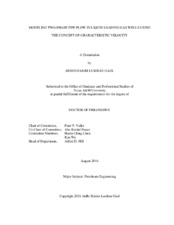| dc.description.abstract | This work focuses on situations of particular significance in natural gas producing wells, when a certain condition brings about drastic liquid content increase, leading to a rich group of phenomena in the field, known as "liquid loading". Under circumstances believed to precede liquid loading, the still steady-state and stable liquid holdup may be several folds larger than the inlet volumetric fraction of the liquid due to partial flow reversal. This leads to increased resistance in the pathway of the produced gas, triggering instability in the coupled well-reservoir system and ultimately causing the end of the natural flow of gas from the reservoir to the surface.
In contrast to the standard models of liquid loading that relate the “onset of liquid loading” to the concept of “critical gas velocity,” we present a new wellbore model that is able to track the most important liquid loading symptom, namely the long-term gradual increase of overall wellbore liquid content and the progression of the strongly related bottomhole pressure.
The new empirical correlation was developed based on the multiphase upward flow measurement in a long vertical pipe. The model is shown to have capability in reproducing various published experimental and vertical gas well data sets with a reasonable accuracy. Additionally, we applied the new wellbore formulation in deviated gas wells affected by both liquid loading situations as well as artificial lift systems.
The new model is a flow-pattern-dependent correlation, hence, convenient to be used for simultaneous multi-well calculations. The derivation is straightforward, while still able to capture the physics of two-phase conditions. The results indicate that the new wellbore model is suitable to be used in analyzing and diagnosing liquid loading culmination processes. An increased was observed in the liquid content and corresponding flowing bottomhole pressure before gas production became interrupted. Additionally, the new correlation provides a more realistic contribution from each pressure gradient component. | en |


